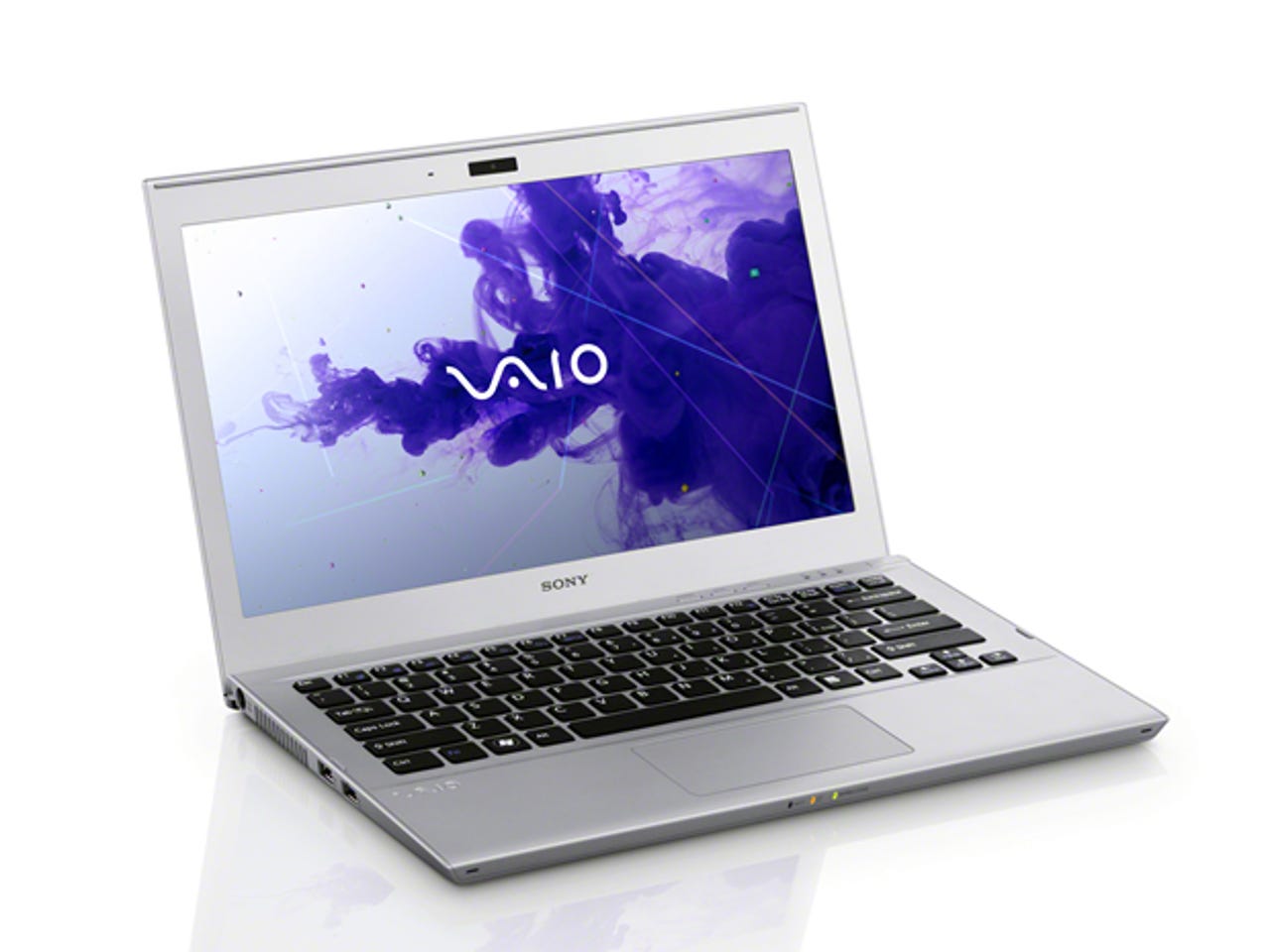Sony VAIO T13 review


Sony VAIO T13
Sony took its time to launch an ultrabook, which is perhaps unsurprising given that its ultrathin and ultralight VAIO Z series has been around for some years and is still going strong. Still, the VAIO T is a bona fide ultrabook, the T13 variant sporting a 13.3in. screen. What's interesting about the VAIO T is that it's a relatively affordable model.
Design
Unlike most ultrabooks, the VAIO T13 does not taper to a thin front — nor is it particularly thin overall. It measures 32.3cm wide by 21.6cm deep by 1.78mm thick and weighs 1.5kg, and actually feels a bit oversized. Other notebooks with a similar profile can pack in an optical drive, for example, which is missing here.
We're not sure we like the forward-leaning, angled front section either. The lid protrudes further than the base, making it difficult to see the status lights from all angles. This is odd as they've been thoughtfully positioned on the front edge precisely so that they can be visible.
Still, the bright shiny chassis that includes a brushed aluminium lid which gives way to a reflective silver strip all along the back edge (complete with Sony logo), will certainly stand out in the office and on the train. The metal lid exhibits a little more flex than we'd like, though, and it is not matched by metal on the insides – the base and screen bezel are both silver plastic.
Although the VAIO T13's external appearance is attractive, we're less happy with the general build quality. The joins between the chassis sections that form the keyboard surround and edges, and the screen bezel and lid are obvious and very slightly gappy. There's certainly no unibody-style smoothness to the appearance. This notebook looks great with the lid down, but less so when opened up.
With the VAIO T13 open, the back section is slightly raised, the lid resting on two tiny black feet that punctuate that shiny silver strip along the back of the chassis. This only lifts the keyboard a few millimetres from the horizontal and makes negligible difference to typing comfort, but the two feet look a little out of place.
The keyboard is not backlit, although light bleed on some backlit VAIO keyboards is an issue, so perhaps we can live with that. The chiclet design means that keys are well spaced. The keys have minimal vertical movement, which we rather like as it helps with speedy touch typing. This is a matter of personal taste, though, and if you like very responsive keys you'll be out of luck here.
The cursor keys are are slightly detached from the main group, making them easy to find by touch alone. They also double up for Home, End, PgUp and PgDn functions. Above the number row are the F1-F12 keys, seven of which have secondary functions: switching to an external monitor; disabling the touchpad; volume up/down/mute; and brightness up/down. There are no media control keys.
The touchpad has integrated buttons, is responsive to finger sweeps and has scroll zones that work smoothly. Zooming in and out of web pages was a little jerky, however.
Originally launched with an 11.6in. display as the VAIO T, the VAIO T13 has, as its name suggests, a larger 13.3in. screen. This has a standard resolution of 1,366 by 768 pixels and a reflective finish. As ever, we found the screen difficult to use with a light source to the rear, and viewing angles on the vertical plane are quite poor — the horizontal plane offers good viewing angles though.
Features
When the VAIO T13 first appeared it was powered by Intel Sandy Bridge processor, but there has been an Ivy Bridge upgrade and our review model had a third-generation Core i5-3317U processor, clocked at 1.7GHz (2.6GHz with Turbo Boost). There's 4GB of RAM, expandable to 8GB. Graphics are integrated, courtesy of by Intel's HD 4000 GPU.
There were three preconfigured models of the VAIO T13 available online at the Sony store at the time of writing, only one of which ran Windows 7 Professional. That model was unpriced online, but our review sample, running Windows 7 Home Premium, was priced at £799 (inc. VAT; £665.83 ex. VAT). Another version with an Intel Core i3-2356M, again running Home Premium, cost £579 (inc. VAT; £482.50 ex. VAT).
Wi-Fi (802.11b/g/n) and Bluetooth (4.0) are present, of course, along with Gigabit Ethernet. Our review sample had a 128GB SSD — if you want more storage, then the least expensive model in the range offers a 320GB hard drive spinning at (a moderate) 5,400rpm.
The relatively chunky VAIO T13 can accommodate full-size ports rather than the miniature versions often used in ultrabooks. This means you don't need adapters, which ultrabook makers are generally loath to bundle. There are full-size VGA and HDMI ports on the right-hand side, along with a headset jack, a card reader for SD and Memory Stick media, and an Ethernet (RJ-45) port.
On the left is a pair of USB ports, only one of which is USB 3.0. These ports are ranged side by side, so plugging in a large USB stick or dongle may obscure the second port. The power connector is also on the right.
The front-facing 1.3-megapixel webcam can be used with Sony's gesture-control app. Sweeping left and right gestures take you forward and back — for example when browsing web pages. A downward sweep will invoke a pause. Clockwise hand rotation turns volume up, anticlockwise turns it down. You can use these gestures in Internet Explorer, Windows Media Player and Media Gallery. Allegedly. We could not get this system to work for us at all, possibly due to the dimly-lit office in which we were working.
Performance & battery life
The Windows Experience Index (WEI) rating for the VAIO T13 is 4.6 (out of 7.9), the WEI corresponding to the lowest component score. As usual for systems with integrated graphics, this was for Graphics (desktop performance for Windows Aero).
The top score, an unimprovable 7.9, went to Primary hard disk (Disk data transfer rate), thanks to that 128GB SSD. The other component scores were 6.9 for Processor (Calculations per second), 6.2 for gaming graphics (3D business and gaming graphics performance) and 5.9 for RAM (Memory operations per second).
This adds up to a notebook that'll perform fine with mainstream business workloads, but is underpowered for demanding graphical applications or games.
In true ultrabook style, the battery is not removable. Sony claims you should get up to nine hours' life, which ought to mean you'll get through a working day. Our (demanding) test was to play video continuously from a USB stick with Wi-Fi left on. Under the 'balanced' power plan we got 4 hours 34 minutes of playback, which is a reasonably strong showing.
Sound output is assisted by xLOUD, a volume-enhancing system we've also seen in Sony's Xperia smartphones. We've been impressed with its handset performance, but it performs less well here: audio quality isn't great, with a lack of bass even at quieter volume levels.
Conclusion
The VAIO T13 ultrabook is attractively priced, but Sony has made a number of compromises to achieve this. The keyboard may not suit everyone, and there are some issues with build quality. If you want a really small, really light, great looking and highly functional notebook from Sony the VAIO Z is probably a better bet — but prepare to pay considerably more for it.